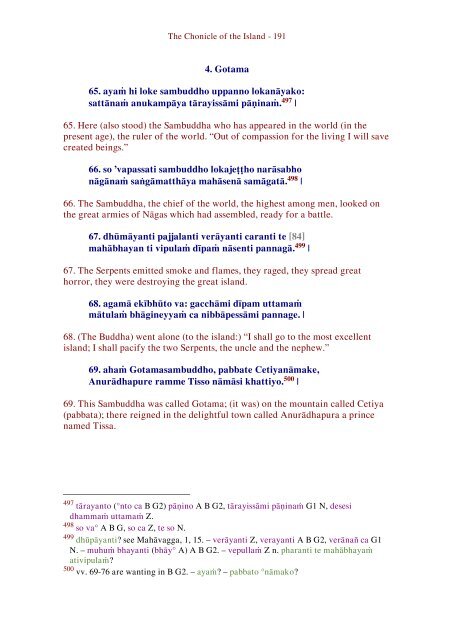Dipavamsa, the Chronicle of the Island
The earliest attempt to write a Chronicle of the Sāsana and the Kings of Sri Lanka, from earliest times up to the 5th c. A.D. Includes both text and translation.
The earliest attempt to write a Chronicle of the Sāsana and the Kings of Sri Lanka, from earliest times up to the 5th c. A.D. Includes both text and translation.
You also want an ePaper? Increase the reach of your titles
YUMPU automatically turns print PDFs into web optimized ePapers that Google loves.
The Chonicle <strong>of</strong> <strong>the</strong> <strong>Island</strong> - 191<br />
4. Gotama<br />
65. ayaṁ hi loke sambuddho uppanno lokanāyako:<br />
sattānaṁ anukampāya tārayissāmi pāṇinaṁ. 497 |<br />
65. Here (also stood) <strong>the</strong> Sambuddha who has appeared in <strong>the</strong> world (in <strong>the</strong><br />
present age), <strong>the</strong> ruler <strong>of</strong> <strong>the</strong> world. “Out <strong>of</strong> compassion for <strong>the</strong> living I will save<br />
created beings.”<br />
66. so ’vapassati sambuddho lokajeṭṭho narāsabho<br />
nāgānaṁ saṅgāmatthāya mahāsenā samāgatā. 498 |<br />
66. The Sambuddha, <strong>the</strong> chief <strong>of</strong> <strong>the</strong> world, <strong>the</strong> highest among men, looked on<br />
<strong>the</strong> great armies <strong>of</strong> Nāgas which had assembled, ready for a battle.<br />
67. dhūmāyanti pajjalanti verāyanti caranti te [84]<br />
mahābhayan ti vipulaṁ dīpaṁ nāsenti pannagā. 499 |<br />
67. The Serpents emitted smoke and flames, <strong>the</strong>y raged, <strong>the</strong>y spread great<br />
horror, <strong>the</strong>y were destroying <strong>the</strong> great island.<br />
68. agamā ekībhūto va: gacchāmi dīpam uttamaṁ<br />
mātulaṁ bhāgineyyaṁ ca nibbāpessāmi pannage. |<br />
68. (The Buddha) went alone (to <strong>the</strong> island:) “I shall go to <strong>the</strong> most excellent<br />
island; I shall pacify <strong>the</strong> two Serpents, <strong>the</strong> uncle and <strong>the</strong> nephew.”<br />
69. ahaṁ Gotamasambuddho, pabbate Cetiyanāmake,<br />
Anurādhapure ramme Tisso nāmāsi khattiyo. 500 |<br />
69. This Sambuddha was called Gotama; (it was) on <strong>the</strong> mountain called Cetiya<br />
(pabbata); <strong>the</strong>re reigned in <strong>the</strong> delightful town called Anurādhapura a prince<br />
named Tissa.<br />
497 tārayanto (°nto ca B G2) pāṇino A B G2, tārayissāmi pāṇinaṁ G1 N, desesi<br />
dhammaṁ uttamaṁ Z.<br />
498 so va° A B G, so ca Z, te so N.<br />
499 dhūpāyanti? see Mahāvagga, 1, 15. – verāyanti Z, verayanti A B G2, verānañ ca G1<br />
N. – muhuṁ bhayanti (bhāy° A) A B G2. – vepullaṁ Z n. pharanti te mahābhayaṁ<br />
ativipulaṁ?<br />
500 vv. 69-76 are wanting in B G2. – ayaṁ? – pabbato °nāmako?

















